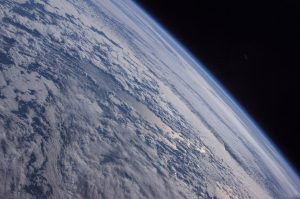
A low level of atmospheric oxygen in Earth’s middle ages held back evolution for 2 billion years, raising fresh questions about the origins of life on this planet.
New research by the University of Exeter explains how oxygen was trapped at such low levels.
Professor Tim Lenton and Dr Stuart Daines of the University of Exeter Geography department, created a computer model to explain how oxygen stabilised at low levels and failed to rise any further, despite oxygen already being produced by early photosynthesis. Their research helps explain why the ‘great oxidation event’, which introduced oxygen into the atmosphere around 2.4 billion years ago, did not generate modern levels of oxygen.
In their paper, published in Nature Communications, Atmospheric oxygen regulation at low Proterozoic levels by incomplete oxidative weathering of sedimentary organic carbon, the University of Exeter scientists explain how organic material — the dead bodies of simple lifeforms — accumulated in the earth’s sedimentary rocks. After the Great Oxidation, and once plate tectonics pushed these sediments to the surface, they reacted with oxygen in the atmosphere for the first time.
The more oxygen in the atmosphere, the faster it reacted with this organic material, creating a regulatory mechanism whereby the oxygen was consumed by the sediments at the same rate at which it was produced.
This mechanism broke down with the rise of land plants and a resultant doubling of global photosynthesis. The increasing concentration of oxygen in the atmosphere eventually overwhelmed the control on oxygen and meant it could finally rise to the levels we are used to today.
This helped animals colonise the land, leading eventually to the evolution of humankind.
The model suggests atmospheric oxygen was likely at around 10% of present day levels during the two billion years following the Great Oxidation Event, and no lower than 1% of the oxygen levels we know today.
Professor Lenton said: “This time in Earth’s history was a bit of a catch-22 situation. It wasn’t possible to evolve complex life forms because there was not enough oxygen in the atmosphere, and there wasn’t enough oxygen because complex plants hadn’t evolved — It was only when land plants came about did we see a more significant rise in atmospheric oxygen.
“The history of life on Earth is closely intertwined with the physical and chemical mechanisms of our planet. It is clear that life has had a profound role in creating the world we are used to, and the planet has similarly affected the trajectory of life. I think it’s important people acknowledge the miracle of their own existence and recognise what an amazing planet this is.”
Life on earth is believed to have begun with the first bacteria evolving 3.8 billion years ago. Around 2.7 billion years ago the first oxygen-producing photosynthesis evolved in the oceans. But it was not until 600 million years ago that the first multi-celled animals such as sponges and jellyfish emerged in the ocean. By 470 million years ago the first plants grew on land with the first land animals such as millipedes appearing around 428 million years ago. Mammals did not rise to ecological prominence until after the dinosaurs went extinct 65 million years ago. Humans first appeared on earth 200,000 years ago.
Reference:
Stuart J. Daines, Benjamin J. W. Mills, Timothy M. Lenton. Atmospheric oxygen regulation at low Proterozoic levels by incomplete oxidative weathering of sedimentary organic carbon. Nature Communications, 2017; 8: 14379 DOI: 10.1038/NCOMMS14379
Note: The above post is reprinted from materials provided by University of Exeter.










